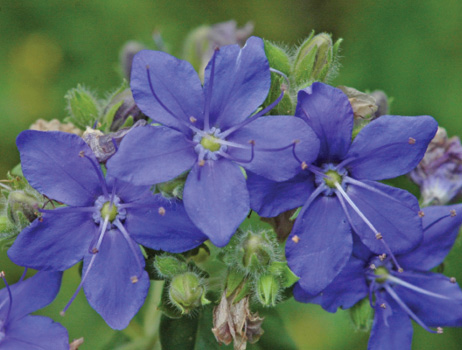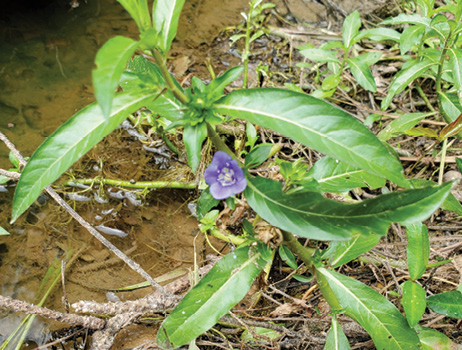Waterleaf | Hydrolea spp.
Emergent | Native



Also known as blue waterleaf, ovate false fiddleleaf, or waterpod, this native species is a sprawling and sturdy marginal plant that can grow up to 3 feet high. It is characterized by hairy, ovate leaves, blue flowers, and spines on the stem.
Multiple stems grow from the base and branch toward the top of the plant. Leaves grow alternately on the stem and are an inch wide and 2 to 3 inches long. A heavy spine, up to a half-inch long, is located just below most leaves.
Flowers grow in clusters of hairy buds at the ends of stems, and buds open to reveal bright-blue flowers with five lobes, long, blue to purple stamens, and yellowish centers and pistils. Flowers are about 1 inch wide.
Management Value
Waterleaf is a native species but has no known food value for wildlife. It may provide physical habitat for fish when flooded, but it is generally not a valuable species in pond management. It can form dense stands that interfere with recreational use, and spines can be harmful to livestock, wildlife, and humans. It is not recommended for establishment in ponds.
Recommended Controls
Option 1: Glyphosate (5.4-pound formulation). For each gallon of water, mix 1.0 ounce glyphosate and 1.3 ounces non-ionic surfactant. Spray to wet all plants. Do not exceed annual herbicide rate limits as stated on the product label.
Multiple herbicide applications may be necessary to eradicate plants.
Read and follow all chemical label instructions, especially the section on the use of personal protection equipment.
Photo Credits Top: Larry Allain, United States Geological Survey

The information given here is for educational purposes only. References to commercial products, trade names, or suppliers are made with the understanding that no endorsement is implied and that no discrimination against other products or suppliers is intended.
Publication 3735-40 (POD-11-23)
By Wes Neal, PhD, Extension/Research Professor, Wildlife, Fisheries, and Aquaculture; Dennis Riecke, Fisheries Coordinator, Mississippi Department of Wildlife, Fisheries, and Parks; and Gray Turnage, PhD, Assistant Research/Extension Professor, GeoSystems Research Institute.
The Mississippi State University Extension Service is working to ensure all web content is accessible to all users. If you need assistance accessing any of our content, please email the webteam or call 662-325-2262.



